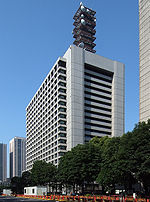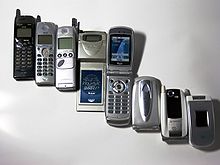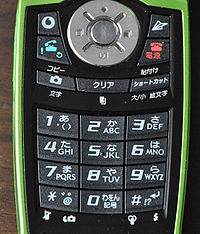- Mobile phone industry in Japan
-
The Japanese mobile phone industry is one of the most advanced in the world. According to statistics announced from the Ministry of Internal Affairs and Communications, as of June 2009 there were 113.025 million mobile phones in use in Japan. This is a 4.4 percent increase over 2008, and is 85 percent of Japan's total population.[1]
In Japanese, mobile phone handsets (携帯電話端末 keitaidenwa-tanmatsu) are often referred to as simply keitai denwa (携帯電話) or keitai (携帯) for short.
Contents
History
- In 1979, Nippon Telegraph and Telephone (NTT) launched the world's first first generation (1G) mobile phone service in Tokyo as a car phone.
- In 1985, NTT offered Japan's first mobile phone service, called the "Shoulder Phone."
- In 1988, Mobile Communication Group, which later was absorbed into KDDI, started mobile phone service
- In 1993, NTT DoCoMo started its first digital mobile phone service (2G), using a Time division multiple access (TDMA) variant called Personal Digital Cellular.
- In 1994, Digital Phone Group and Tu-Ka Group, both of which later became SoftBank Mobile, started mobile phone service. In he same year, DDI Pocket, a subsidiary of KDDI, started PHS mobile phone service.
- In 1999, NTT DoCoMo started i-mode Internet service.
- In 2001, NTT DoCoMo premiered the world's first Third Generation mobile phone service (3G), using W-CDMA technology called FOMA.
- In 2002, KDDI started 3G service in Okinawa, using CDMA2000 technology. In the same year, J-Phone started 3G service using W-CDMA technology.
- In 2003, J-Phone changed its name to Vodafone.
- In 2006, Vodafone Japan was purchased by SoftBank and renamed to SoftBank Mobile. In the same year, MNP(Mobile Number Portablity) was introduced.
- In 2007, Japanese regulator introduced new guideline for unbundling new handset price and service plan.
- In 2010, SoftBank Mobile will stop all non-3G services, focusing on 3G service only.
Providers
There are four cellular service operators in Japan. Willcom is the last PHS Personal Handy-phone System service operator.[2]
NTT DoCoMo
DoCoMo was spun off in 1991 from Nippon Telegraph and Telephone (NTT), NTT DoCoMo first offered its second-generation service known as Personal Digital Cellular (PDC). It now offers a 3G service using W-CDMA technology known as FOMA. The company is operating a world band W-CDMA network at 2100 MHz. As of September 2010, the number of subscribers is 56 million.
KDDI
KDDI was formed by the merger of KDD (International phone service operator), DDI (nationwide CDMA operator except for Kanto and Tokai area), and IDO (CDMA operator for Kanto and Tokai area) in 2000. They offer the au mobile phone service: its second generation service, using CDMA technology, and 3G service, using CDMA2000. Their operating bands are 800 MHz and 2100 MHz. As of September 2010, there are 32 million subscribers.
SoftBank Mobile
Softbank Mobile is a subsidiary of Softbank. Softbank purchased Vodafone Japan at $15b in 2006. Softbank Mobile now offers 3G service using W-CDMA technology at 2100 MHz. Softbank Mobile is also the exclusive service provider of Apple iPhone in Japan. As of September 2010, there are 23 million subscribers.
EMOBILE
EMOBILE, a subsidiary of eAccess, is the most recent entrant into the 3G market. Beginning in 2005, it has provided 3G data and voice service coverage to 90% of the Japanese population through its own network and a roaming agreement with NTT DoCoMo.[3] Their band is 1700 MHz which is not compatible with other area's W-CDMA phone. The primary service of EMOBILE is wireless Internet access. As of September 2010, there are 2.6 million subscribers.
Willcom
DDI Pocket, a PHS subsidiary of DDI was acquired by Carlyle Group and renamed to Willcom in 2004. The company is the only remaining provider of Personal Handy-phone System (PHS) services. As of February 2010, the company filed for bankruptcy protection in the Tokyo District Court. The court appointed Ken Miyauchi, COO of Softbank Mobile as bankruptcy trustee of Willcom. As of September 2010, the number of subscribers is 3.8 million.
In addition, there are also other mobile communications companies and MVNOs, such as Disney Mobile and Nihon Tsushin, that provide service to a limited area or entirely via another carrier's network.
Industry
 Central Government Bldg. No. 2 in Tokyo where the Ministry of Internal Affairs and Communications is housed.
Central Government Bldg. No. 2 in Tokyo where the Ministry of Internal Affairs and Communications is housed.
The Japanese mobile phone market is known for its extremely competitive and saturated market, which, combined with a complex regulatory environment, has led to growing consolidation among manufacturers and providers alike.
Mobile telecommunications operating licenses are administered by the Ministry of Internal Affairs and Communications. In Japan, there have never been band license auction. Usually MIC issued operating licenses by just paper checking.
Collaboration by the various companies can be seen at the Yokosuka Research Park, near NTT's Yokosuka R&D Center, where many manufacturers have research and development laboratories offices. An outdoor testing site is also located there.
Since the introduction of new regulation about unbundling service plan and handset price in 2008, Japanese handset market was shrinked. At peak time, 2007, total handset shipping recorded roughly 52M units. However,same number of 2009 was roughly 32M units. This caused serious recession for handset industry and consolidation of handset vendors because most of handset vendors relied on solely Japanese market.
Japan's PHS technology has been exported to China, Taiwan and other countries. NTT DoCoMo's i-mode web technology had been used by Australia's Telstra, Russia's Mobile TeleSystems, UK's O2 and few other mobile service providers overseas. NTT has been one of the main contributors to the 3G W-CDMA standard. NTT DoCoMo collaborated with AT&T Mobility to set up a 3G-compatible mobile phone network in Hawaii.[4]
Handsets
Manufacturers
The following manufacturers currently market and sell handsets within Japan:
Japanese
- Fujitsu-Toshiba
- Kyocera
- NEC-Casio
- Panasonic
- Sharp
- Sony Ericsson
Non-Japanese
- Apple
- Research in Motion
- HTC
- LG Electronics
- Huawei
- Samsung
- ZTE
- Motorola
Sanyo Electric, although formerly an independent manufacturer of handsets, sold its handset business to Kyocera in 2008.[5] Mitsubishi Electric quit mobile phone business in Apr 2008.[6] Nokia discontinued development of mobile phones for Japanese market in 2009.[7] DoCoMo M702iS which was released on December 2006, is the last Motorola phone for Japan, but in 2011 Motorola returns to sell its handset for Japan.
Japanese manufacturers have had difficulty in attracting consumers in overseas markets to their phones. In 2009, out of all Japanese handset manufacturers, Sony Ericsson sold the most handsets worldwide (after non-Japanese Nokia, Samsung, LG Electronics and Motorola);[8] domestically, Sharp sold one quarter of the Japanese market, followed by Fujitsu, Panasonic, NEC and Kyocera.[9]
Operating system
Japan's mobile phones traditionally used the iTron operating system, but as the functions become more complex, they have begun to employ more generally used operating systems, such as Symbian OS, Embedded Linux, Windows Mobile and Android. Most handsets on the market today use one of either Symbian OS, REX OS, or Embedded Linux.
Language input
Input on mobile phones is performed using hiragana, katakana, kanji, and alphanumeric characters. A character mode function allows the user to select from among these types of character input. Kanji characters are selected by first inputting hiragana, then converting (変換 henkan) the characters. Kana characters are laid out on the mobile phone keys in the 50 character table format: A-column characters on 1 key, Ka-column characters on the 2 key, etc.
The alphabetic character mode allows input of Roman characters; however, English-language word prediction (such as T9) is rarely implemented in Japanese handsets. Support for other languages and character sets, such as French, Russian (Cyrillic), and Chinese (both traditional and simplified characters), is not standard on handsets from domestic manufacturers.
Other characteristics
The Japanese are known for their development of emoji (絵文字 lit. "picture characters") and kaomoji (顔文字 lit. "face characters") to express emotions in email messages. A large number and variety of emoji and kaomoji are available on handsets. Foreign manufacturers (such as Apple), in order to ensure compatibility with Japanese-made handsets, have introduced emoji on their handsets around the world. Gmail and other email services have also introduced emoji that can be sent and received from mobile handsets as well as computers.
Unique business practices
- All handsets sold in Japan are "locked" for use in Japan only, due to the demands of service providers. Likewise, providers have also refused to sell USIM cards by themselves without a handset or for a handset brought in from overseas, although NTT DoCoMo has recently has relaxed this business practice. As the Ministry of Internal Affairs and Communications' mobile business consultative committee advised in 2007, likelihood this locking practice will be lifted in 2011.
See also
- Mobile phone
- Telecommunications in Japan
- Mobile phone industry in China
- Mobile phone industry in Russia
- Mobile phone industry in India
- Mobile phone industry in South Korea
- Mobile phone industry in the United States
References
- ^ CNET Japan News (Japanese)
- ^ Mobile phone businesses (携帯電話事業) and PHS businesses (PHS事業) are treated separately under Japanese law due to differences in transmission methods and radio frequencies.
- ^ EMOBILE Service Area (Japanese)
- ^ NTT Collaborated with AT&T Mobility to Set Up 3G Network in Hawaii (2007) (Japanese)
- ^ Kyocera consolidated Sanyo Wireless in San Diego
- ^ No more Mitsubishi Mobile Phones. by Softpedia
- ^ Nokia Press Release
- ^ Gartner reports the 2009 worldwide mobile handset sales (Japanese)
- ^ IDC reports 3Q/2009 results of the mobile handset sales in Japan (Japanese)
Mobile phone industry in Asia Sovereign
statesAfghanistan · Armenia · Azerbaijan · Bahrain · Bangladesh · Bhutan · Brunei · Burma (Myanmar) · Cambodia · People's Republic of China · Cyprus · East Timor (Timor-Leste) · Egypt · Georgia · India · Indonesia · Iran · Iraq · Israel · Japan · Jordan · Kazakhstan · North Korea · South Korea · Kuwait · Kyrgyzstan · Laos · Lebanon · Malaysia · Maldives · Mongolia · Nepal · Oman · Pakistan · Philippines · Qatar · Russia · Saudi Arabia · Singapore · Sri Lanka · Syria · Tajikistan · Thailand · Turkey · Turkmenistan · United Arab Emirates · Uzbekistan · Vietnam · Yemen
States with limited
recognitionAbkhazia · Nagorno-Karabakh · Northern Cyprus · Palestine · Republic of China (Taiwan) · South Ossetia
Dependencies and
other territoriesChristmas Island · Cocos (Keeling) Islands · Hong Kong · Macau
Categories:- Telecommunications in Japan
- Mobile phones by country
Wikimedia Foundation. 2010.


